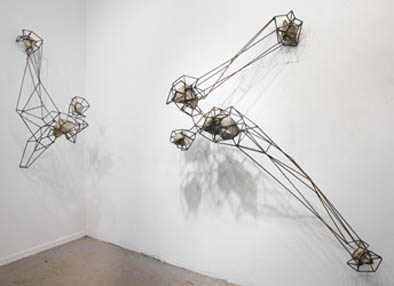|
|||||
|
|||||
For this show, Baugh-Sasaki--an outdoorsman as well as an artist-has climbed some of the highest peaks in California, seeking out the source waters for rivers and canals that hydrate the Bay Area and beyond. As the waters flow, forced into channels of their own making or into man-made pathways, they shape and form everything we see, creating new relationships, conflicts, and balance in the “natural environment” as worlds collide and combine. The artist, a native of San Francisco, specifically wanted to explore his hydrological lifeline: the Hetch Hetchy Aqueduct and its watershed. He wanted to witness its transformation from wild, energetic flow into domesticated, contained resource. To trace this route, Baugh-Sasaki ascended Mt. Dana at 13,057 ft. to the base of Mt. Lyell, followed the water down into the Yosemite high-country along the Tuolumne River, where it traverses through the Sierra Nevada foothills into the canals that carry it across the Central Valley, finally entering the urban spaces of the South Bay until it arrives at its terminus at the Pulgas Water Temple in Woodside--a 200 mile-trek across the state of California. Baugh-Sasaki's literal and metaphorical understanding of this complex journey serves as the point of departure for this not-to-be-missed show at Krowswork. This exhibition will include two large video-sculpture installations that emulate the natural pathways and refined channeling that is emblematic of the water’s (and therefore the artist’s) journey. It will also feature several beautiful diptych photographs, each juxtaposing images from the two extreme points of the water’s course. What almost any resident of California knows logically--that there is a constant interplay between the “civilized” (read: urban or suburban) and the “wild” (read: the rugged Sierra, John Muir territory)--is made particularly visceral and jarring in these compositions. The artist also presents several wall sculptures in which granite is confined inside steel bracing, poetically symbolizing the containment of natural strength within the arbitrary boundaries of man’s metal cage. These sculptures are accompanied by works on paper whose smoky marks result from using an acetylene torch without enough oxygen to burn or weld. These are automatic and uninhibited, conjuring the fumage techniques employed by the Surrealists. It is an honor to again present the strong, searching work of Mark Baugh-Sasaki, whose ambitious first show at the gallery, where pews turned on end and video sculptures snaked through the space, entranced all who saw it. This exhibition continues the artist’s thorough and poetic work surrounding the relationship between man-made and the natural environments, and art’s ability to unite them. Mark Baugh-Sasaki writes more about his motivation for this exhibiton: The human landscape is ever expanding. As it grows it shapes and forms the natural environment, creating new relationships, interactions and conflicts for balance as the two worlds combine. As a person of both the urban and the wild, I am drawn to explore these new hybrid worlds that have emerged from the merging of the natural and man-made landscapes. I am fascinated by how water shapes our world, both the natural and the human. It carves deep canyons in the desert or in its frozen state vast valleys out of shear rock, as well as, allowing us, as humans, to survive in inhospitable environments or in greater numbers than can be sustained locally. We domesticate wild rivers, create our own lakes and rivers, and transport water from far off distances to suit our purposes. When we create these artificial hydrological systems, new landscapes are born.
|
|||||

